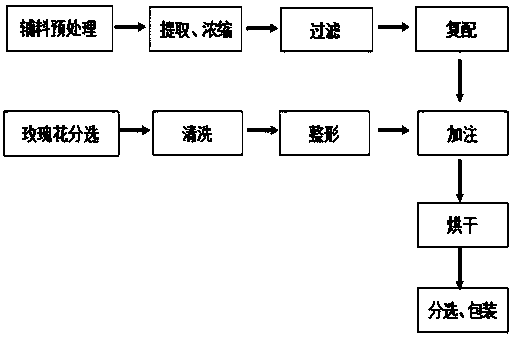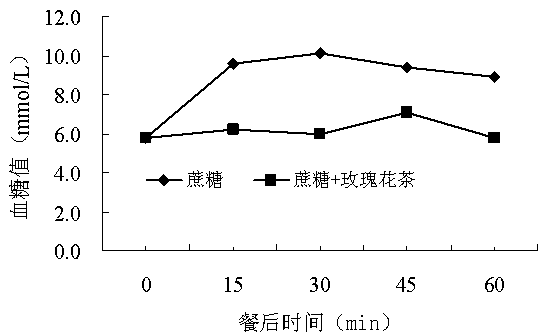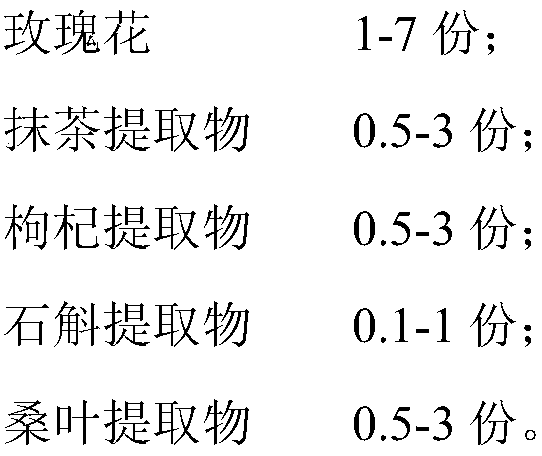Rose flower tea with function of reducing postprandial blood sugar and preparation method thereof
A technology of rose tea and postprandial blood sugar, which is applied in the field of food processing, and can solve the problems of rose tea in reducing postprandial blood sugar, slow leaching speed of active substances, and low content of water-soluble active substances, etc., to reduce postprandial blood glucose levels , Remarkable technical progress, good flavor effect
- Summary
- Abstract
- Description
- Claims
- Application Information
AI Technical Summary
Problems solved by technology
Method used
Image
Examples
Embodiment 1
[0028] The invention provides a kind of rose tea with the function of lowering postprandial blood sugar. The tea is made of the following raw materials in parts by weight:
[0029] 1-7 parts of roses;
[0030] Matcha extract 0.5-3 parts;
[0031] 0.5-3 parts of wolfberry extract;
[0032] Dendrobium extract 0.1-1 part;
[0033] 0.5-3 parts of mulberry leaf extract.
[0034] The invention provides a method for preparing rose tea with the function of lowering postprandial blood sugar.
[0035] Including the following steps:
[0036]1) A preparation step of matcha extract: add matcha raw material (by dry weight) into water and ethanol extract (30% ethanol concentration by mass percentage) in a ratio of 1:10-100 (g:mL) for beating, and heat Extract at 60-100°C for 2-8h, filter with three layers of gauze. The filter residue is then beaten with extract at a ratio of 1:10-50 (g:mL), heated at 60-100°C for 2-8 hours, and filtered with three layers of gauze. Combine the filtrate...
Embodiment 2
[0044] A kind of rose tea with the effect of lowering postprandial blood sugar is prepared by the method comprising the following steps:
[0045] (1), the preparation of matcha extract, specifically comprises the following steps:
[0046] ①. Add 100g of matcha raw material to 5L of ethanol aqueous solution with a concentration of 30% by volume for beating, then control the temperature at 100°C for alcohol extraction for 5 hours, and filter the obtained alcohol extract 1 with three layers of gauze to obtain filtrate 1;
[0047] ②. Add the filter residue obtained after the above filtration to 2.5 L of ethanol aqueous solution with a volume percentage concentration of 30% for beating, then control the temperature to 100°C for alcohol extraction for 5 hours, and filter the obtained alcohol extract 2 with three layers of gauze to obtain the filtrate 2;
[0048] ③. Combine the above-mentioned filtrate 1 and filtrate 2, and then use a rotary evaporator to control the temperature at ...
Embodiment 3
[0070] (1), the preparation of matcha extract, specifically comprises the following steps:
[0071] ①. Add 500 g of matcha raw material to 5 L of ethanol aqueous solution with a volume percentage concentration of 30% for beating, then control the temperature at 90°C for alcohol extraction for 8 hours, and filter the obtained alcohol extract 1 with three layers of gauze to obtain filtrate 1;
[0072] ②. Add the filter residue obtained after the above filtration to 2.5 L of ethanol aqueous solution with a volume percentage concentration of 30% for beating, then control the temperature to 90°C for alcohol extraction for 8 hours, and filter the obtained alcohol extract 2 with three layers of gauze to obtain the filtrate 2;
[0073] ③. Combine the above-mentioned filtrate 1 and filtrate 2, and then use a rotary evaporator to control the temperature to 100°C and vacuum degree 0.08MPa to concentrate to 500mL, squeeze and filter with 6 layers of gauze, and the obtained filtrate is the...
PUM
 Login to View More
Login to View More Abstract
Description
Claims
Application Information
 Login to View More
Login to View More - R&D Engineer
- R&D Manager
- IP Professional
- Industry Leading Data Capabilities
- Powerful AI technology
- Patent DNA Extraction
Browse by: Latest US Patents, China's latest patents, Technical Efficacy Thesaurus, Application Domain, Technology Topic, Popular Technical Reports.
© 2024 PatSnap. All rights reserved.Legal|Privacy policy|Modern Slavery Act Transparency Statement|Sitemap|About US| Contact US: help@patsnap.com










